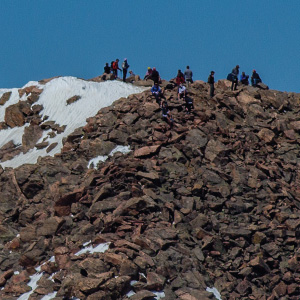
As the temperatures get warmer and the alpine snowfields start to melt, we reach peak summer recreation season in Colorado. During this time, locals and tourists alike will pack their bags full of granola bars and extra layers, setting their alarms for the crack of dawn in pursuit of Colorado’s highest peaks. The centennial state is known for its fourteeners, and reaching all of their gorgeous summits is a lifelong dream of many Coloradans. However, the fourteeners’ increased popularity brings with it higher foot traffic, which may prove detrimental to the health of these majestic mountains.
A fourteener is defined by the United States Geological Survey as a mountain whose peak rises to or above 14,000 ft of elevation above sea level. There is some discrepancy over the status of some of the mountains that claim this title, but it is generally understood that Colorado is home to between 53 and 58 fourteeners. Of these mountains, a few stand out in terms of visitor numbers due to accessibility, difficulty, and notoriety. Some of the state’s most popular peaks include Mt. Elbert (the tallest mountain in Colorado), Longs Peak (located within Rocky Mountain National Park), and Pikes Peak (which gained its fame for inspiring the song America the Beautiful). While these mountains offer amazing summits, their popularity is beginning to cost them the health of their ecosystems, especially the fragile alpine habitat above treeline.
In response to the fourteeners’ alpine degradation, many efforts and projects have already begun to restore and protect these mountains. At the forefront of these efforts is the Colorado Fourteeners Initiative, which currently has ongoing projects on most of Colorado’s most-impacted fourteeners. This organization uses both volunteer and professional labor forces to adjust current trails to their least impactful state, which can include building trail features to reduce erosion, shifting pre-existing trails to less impactful locations, and transplanting alpine soil and flora to degraded areas.
In addition to their restoration efforts, Colorado Fourteeners Initiative is looking towards the future of alpine recreation through their Sustainable Trails Program. This project seeks to educate and engage the public so that they may become citizen stewards of the mountains and trails that they use. The project also aims to use Geographic Imaging System technology to map out a more comprehensive view of the summit trails over time. This will allow the project to more accurately measure the sustainability levels of their past and present projects.
With 334,000 hikers visiting Colorado’s fourteeners annually, it is also important that these users do what they can to help conservation organizations. One of the most important things that hikers can do for these fragile areas is look into some of the less trafficked fourteeners when planning a hike. By opting for a less popular mountain, hikers can work to distribute the weight of their presence while still challenging themselves with a more secluded and natural-feeling experience. Colorado is also home to over 580 mountains above 13,000 ft. These thirteeners offer the same breathtaking views as their more popular counterparts, with a more local and less populated feel.
Home to such natural beauty, Colorado has long been playing the balancing act between conservation and recreation. With tourism at an all-time high in the centennial state, a little bit of research into when and where to hike can go a long way in protecting the high peaks that make Colorado so special.
Malik Geraci is a Naturalist interpretive guide at Walking Mountains Science Center where he leads educational hikes and programs relating to natural science. In his free time, Malik enjoys cooking, rock climbing, and exploring the extensive trail system that Colorado has to offer.









